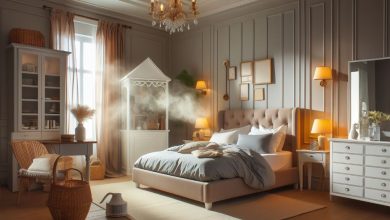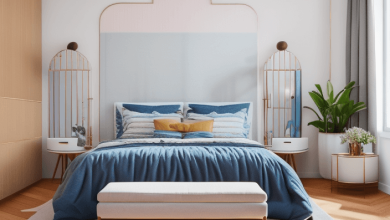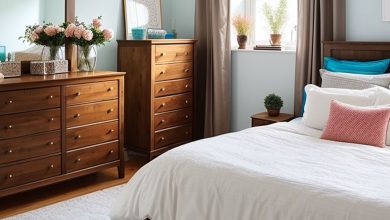How to Keep Air Moist in the Bedroom: Proven Solutions

Having a too-dry bedroom can lead to discomfort and even worsen respiratory conditions. Keeping the air moist in your bedroom is essential to ensure that you sleep in a healthy and comfortable environment. Here are some tips to help you maintain an optimum amount of moisture in your bedroom.
The first step in keeping the air moist in your bedroom is to install a humidifier. Humidifiers allow you to control the air’s moisture level by releasing water vapor into the room. This works best if you select one with adjustable settings to ensure that humidity levels stay within an ideal range. Additionally, clean and sanitize your humidifier regularly to prevent any health risks from the vaporized water.
Another way to add moisture to your bedroom air is to place a pot of water near a heat source. As the water heats up, it will release moisture into the air, making your bedroom more comfortable. You can even place a few drops of essential oils into the water for a pleasant scent. If you’re using this method, check the pot of water regularly to ensure it isn’t running out of moisture or evaporating too quickly.
Finally, leaving clothes or bedding out to air is another simple and natural way to increase moisture in the room. Avoid fabric softeners, as this can make clothes less absorbent, reducing their effectiveness at keeping the air moist. You can also boil a pot on the stove or put cups of hot water around the room; however, this can take up space and be time-consuming.
Following these steps, you can easily maintain healthy humidity levels in your bedroom and enjoy a comfortable sleeping environment.
How to Use Humidifiers for Optimal Bedroom Air Moisture
Humidifiers can be an excellent tool for creating optimal bedroom air moisture. While it’s best to consult your doctor about the ideal humidity level for your bedroom, the general rule of thumb is that you should aim for somewhere between 30 and 50 percent humidity. Here are a few tips to help you get the most out of the humidifier in your bedroom:
- Choose the Right Humidifier for Your Bedroom Size: Knowing the size of your bedroom is essential when choosing the right humidifier. Look for a smaller unit if your bedroom is on the small side. If it’s larger, opt for a larger, more powerful model.
- Monitor the Humidity Level in Your Bedroom: To ensure you achieve the desired humidity level, use a hygrometer to measure the amount of moisture in the air.
- Clean and Maintain the Humidifier: Regularly cleaning and maintaining your unit will ensure it runs efficiently and effectively. Follow the manufacturer’s instructions on how often to clean and replace parts as needed.
- Consider Where You Place Your Humidifier: To get the most efficient use out of your humidifier, consider placing it away from doorways and corners, windows, or other sources of moisture.
- Control Humidifier Output: Make sure not to over-saturate your bedroom by controlling how much moisture is released using manual or digital settings.
Using a humidifier properly can add comfort to your bedroom and overall well-being by optimizing air moisture levels. Following these tips will help ensure you reap all of its benefits.
The Benefits of Having Sufficient Air Moisture in the Bedroom
The proper air moisture in the bedroom is essential to a good night’s sleep. Sleep quality directly impacts our energy levels and overall health, so ensuring that our bedroom environment is as comfortable as possible is necessary.
One of the essential elements of bedroom comfort is air moisture. Too little humidity can lead to nasal congestion, dry skin, and eye irritations, interrupting sleep. Conversely, too much water can lead to mold growth, lingering musty odors, and respiratory illnesses.
The ideal air moisture level in the bedroom is between 30%-50%, providing enough water to keep the air from drying out but not enough for mold growth. This can be achieved by using a humidifier. These devices can regulate the amount of moisture in the air, which can help create a more comfortable atmosphere in the bedroom.
Using a humidifier also has other benefits for sleepers. Adding enough moisture to the air helps reduce the number of dust particles and other allergens in the room, which can trigger asthma attacks or allergy symptoms during sleep. Additionally, a humidifier can help reduce snoring and aid those with sinus issues, as increased moisture in the air helps thin mucus and reduce inflammation.
Finally, having sufficient air moisture in the bedroom can help make the space more inviting. Dry air can make it feel colder than it is, which may contribute to restlessness or prevent you from getting comfortable once you’re in bed. Keeping your bedroom at an optimal humidity level will make it more comfortable so that you can drift off into a restful sleep quickly and easily.
Creative Ways to Add Moisture to the Air in the Bedroom
- Add an air humidifier to the bedroom to increase the air’s moisture level. Air humidifiers come in various sizes, giving you the perfect one to fit in your bedroom. Many modern air humidifiers can be controlled with a simple app and can even be programmed to run at specific times if desired.
- Place house plants around the room. House plants are excellent at removing toxins and adding moisture to the air. Spiders, parlor palms, peace lilies, or focuses are perfect for this purpose.
- Fill a shallow bowl with water and place it in the bedroom. Place a few drops of essential oil, such as lavender or eucalyptus, into the water and allow it to evaporate into the air naturally.
- Hang a damp towel on the bedroom wall near an open window. This allows the humidity from outside to mix with the air inside the room, increasing moisture levels.
- Boil a pot of water on the stove and place it in the bedroom before bedtime. This will create some steam, adding moisture to the air as it cools throughout the night.
- Use essential oil diffusers throughout the bedroom throughout the day, especially in areas that may be more prone to low moisture levels, such as closets or corners of rooms. Essential oils such as peppermint, lavender, and lemon are known for their humidity-raising properties.
Natural Solutions to Increasing Air Moisture in the Bedroom
- An air humidifier is the most common solution for increasing air moisture in the bedroom. Humidifiers work well for small and large bedrooms and can be affordable. However, you must ensure you select a model appropriate for your room size and maintain it regularly to prevent bacterial contamination.
- Plants can also be utilized to increase air moisture in the bedroom naturally. Certain plants, such as ferns, peace lilies, and bromeliads, are particularly effective at releasing water into the air. Not only do they provide natural humidity levels, but they can also help beautify your room!
- Consider using a shallow pan of water for a quick and easy solution to increasing air moisture in the bedroom. Place a pan of water on the floor or windowsill near a heat source such as a radiator or heater. As the water heats up, it will evaporate into the air and increase the humidity in the room.
- Hang damp clothes around the bedroom to provide natural moisture in the air. This is especially effective in winter when indoor air tends to be particularly dry. Just be sure to leave space between the garments so air can circulate properly.
- Fill up vessels such as vases or bowls with water and leave them around the bedroom on window sills or tables. As the water evaporates, it will release moisture into the air, which will help increase humidity levels in the bedroom. Be sure to change the water regularly to avoid bacteria build-up.
The Pros and Cons of Installing a Dehumidifier in the Bedroom
Installing a dehumidifier in the bedroom can provide numerous health benefits, but it can also have some drawbacks. Dehumidifiers are designed to reduce the humidity in a room by extracting moisture from the air and releasing it outside. This can be especially useful in bedrooms, as high humidity levels can lead to an uncomfortable sleeping environment, mold and mildew growth, and dust mites. Here are some of the pros and cons of installing a dehumidifier in your bedroom:
Pros:
- We have improved air quality by reducing dust mites, mold, and mildew.
- Reduced risk of developing allergies due to dust mites.
- It helps to create a comfortable sleeping environment by controlling humidity levels in the air.
- Lower levels of static electricity in the air due to lower humidity.
- It lessens the chance of damaging wooden furniture from mold or mildew growth.
Cons:
- Higher energy bills due to running the dehumidifier regularly.
- Noise from the dehumidifier may not be conducive to sleeping.
- Maintenance such as emptying the water collection tray and replacing filters.
- Potential health risks if an improperly designed dehumidifier is used.
Exploring Different Types of Humidifiers for the Bedroom
The perfect environment in your bedroom is essential for a great night’s sleep. One way to improve the air quality in your room is to introduce a humidifier. Knowing which type is best for you is essential with so many models on the market.
One popular option is an evaporative humidifier. It uses a fan to draw air from the room, passing it through a wet wick filter. The water evaporates, and the fan releases the moistened air back into the room. While evaporative humidifiers are generally more affordable than most other types, they require regular maintenance.
Another option is warm mist humidifiers. These use a heating element to create steam that is pushed into the room. These models are great for relieving congestion and sore throats, but they should not be used around children or pets due to their hot surfaces and the potential danger of hot steam burns.
Ultrasonic humidifiers use high-frequency vibrations to create a mist dispersed into the air. These are much quieter than other types and can often run continuously without refilling. However, they can be costly upfront, and some may put out less moisture than other models.
Finally, there are impeller humidifiers. This type uses a rotating disk to fling water droplets into the air. They tend to be inexpensive and relatively low maintenance; however, some users report emitting too much noise, and mineral deposits can build up quickly in the tank.
No matter what type you decide, it’s essential to ensure you replace filters regularly and keep the unit clean to get the best results. With so many options available, finding out which type of humidifier best suits your needs will ensure you get great sleep for years to come.
The Role of Air Conditioning in Controlling the Air Moisture in the Bedroom
Air conditioning is essential in controlling a bedroom’s humidity levels. Properly managed air conditioning can help keep the air dry and comfortable in a bedroom, reducing the chances of mold and mildew.
The primary function of an air conditioner is to cool and dehumidify the air. The cooling system works by taking a stand from the indoor space and transferring it to the outside, where it is cooled and reintroduced into the bedroom. The dehumidification process removes moisture from the air so that it is at a comfortable level.
When properly installed, an air conditioner can help maintain a consistent humidity level in the bedroom. This ensures that rooms are not too humid or dry, creating an ideal environment for sleeping. On hot summer days, an air conditioner can keep the room cool while reducing relative humidity to create a much more comfortable sleeping environment.
In addition to cooling and dehumidifying, an air conditioner can help filter airborne pollutants such as dust, pollen, and pet dander. This helps to improve indoor air quality by removing contaminants from the bedroom environment.
Overall, an air conditioner can provide comfort and improve indoor air quality by reducing the moisture in the bedroom air. Keeping humidity levels under control can help prevent mold and mildew from forming, creating a healthier and more comfortable sleeping environment.
How to Maintain an Ideal Humidity Level in the Bedroom
Maintaining an ideal humidity level in the bedroom is essential for creating a comfortable and healthy sleeping environment. Here are some tips to help you maintain a perfect humidity level in your bedroom:
- Invest in a dehumidifier. A dehumidifier is a great way to remove excess moisture from the air and help maintain the optimal humidity level in the bedroom. Follow the manufacturer’s instructions, as each unit may vary.
- Use exhaust fans in your bathroom and kitchen. Running an exhaust fan after showering or cooking will help keep excess moisture out of the bedroom and reduce overall humidity levels.
- Open windows regularly. Opening windows during the day helps keep fresh air circulating through the room and helps reduce airborne moisture levels.
- Inspect all pipes and appliances for leaks. Leaky pipes and machines can cause elevated moisture levels, leading to an unhealthy sleeping environment. Fix any leaks promptly to help maintain an ideal humidity level in the bedroom.
- Keep plants out of the bedroom. Houseplants can add moisture to a room, so it’s best to keep them away from your sleeping area to keep your humidity levels low.
Following these tips, you can maintain an ideal humidity level in your bedroom and ensure a comfortable and healthy sleeping environment.
Tips for Keeping Air Moist in a Bedroom with No Windows
Air moisture in the bedroom can be a concern, particularly if the room has no windows. Fortunately, some simple tips can help you keep the air in your windowless bedroom and maintain its moisture level.
The first tip is to make sure that your bedroom is properly ventilated. Invest in an air fan to circulate the air and get rid of any stale odors that may be present in the room. You can also keep a window open or install an exhaust fan to maintain airflow.
Secondly, consider investing in a humidifier. This device produces a fine mist of water vapor that helps keep the atmosphere more moist. Placing the humidifier close to your bed can help ensure even moisture levels throughout your room.
Thirdly, create a mini-greenhouse by keeping a water bowl close to your bedside. The water will evaporate over time, keeping the air moist and comfortable. Or you can also opt to set up several potted plants in your bedroom and let them absorb moisture from the air around them.
Finally, try using essential oils or incense sticks, which can spread moisture into your bedroom when burned. The aromatic scent of some essential oils can also help improve relaxation, making your bedroom more inviting and cozy.
By following these tips, you can keep the air of your bedroom moist and comfortable even if it doesn’t have windows. You can keep the atmosphere pleasant and humid all year round with proper ventilation, a humidifier, water bowls and plants, and essential oils.
Simple Ways to Monitor Air Moisture in the Bedroom
Monitoring the air moisture in your bedroom is crucial to ensure that the air quality in your bedroom is maintained correctly. By monitoring the air moisture, you can ensure that any allergens and dust particles in the air are kept at bay. Here are some simple ways to monitor air moisture in the bedroom:
- Place a Hygrometer in Your Bedroom: A hygrometer is a device that reads the humidity level in your bedroom. It is accurate and reliable and can help keep the air moist and in check.
- Use an Air Filter: An air filter can help reduce the dust and allergens in your room. This will help to keep the air quality clean and healthy.
- Monitor Temperature and Humidity: To ensure that your bedroom is comfortable and healthy, it is essential to keep track of your room’s temperature and humidity levels. This can be done using thermostats or humidity monitors.
- Use Air Conditioners or Dehumidifiers: An air conditioner or dehumidifier can help reduce your bedroom’s humidity levels. Threduce your bedroom’s humidity levels during the amount of sweat produced when you sleep.
- Adjust Ventilation: Adjusting ventilation and airflow in your bedroom can also help to reduce the amount of moisture in the air and keep it comfortable throughout the night.
By monitoring the air moisture in your bedroom, you can ensure that your room remains comfortable and healthy. Gradually adjusting and setting up an appropriate humidity range is critical to maintaining good air quality in your bedroom.
Conclusion
Maintaining a proper humidity level in a bedroom is essential for a comfortable living environment. There are various ways to ensure the air remains moist and prevents dryness or musty odors.
The most crucial factor in keeping the air moist in the bedroom is proper ventilation. Keeping windows open, particularly during dry periods, will allow fresh air to circulate throughout the room and reduce the chances of musty odors. Additionally, investing in a humidifier can help to add moisture to the air and fight against dryness. This can be especially helpful during winter when cold air infiltrates the space and dries out the air inside the bedroom.
Finally, keeping plants in the bedroom can also help to keep moisture in the air. Most plants require some form of humidity to thrive and will naturally increase the moisture levels in the room with their presence. Furthermore, these plants can provide mental and aesthetic benefits, making them a great addition to any bedroom. Following these tips, you can ensure that your bedroom stays comfortable and has consistent humidity.




